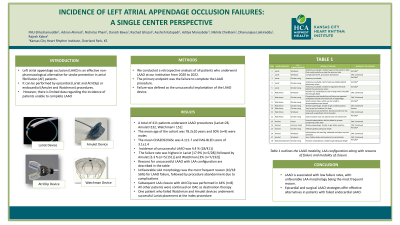Other
Incidence and Outcomes of Left Atrial Appendage Occlusion Failure: A Single-Center Experience

Purpose: Left atrial appendage occlusion (LAAO) is an effective non-pharmacological alternative for stroke prevention in atrial fibrillation (AF) patients. It can be performed by endocardial or epicardial methods. However, there is limited data on patients unable to complete these methods. We subsequently aim to evaluate failed LAAO procedures.
Material and Methods: We conducted a retrospective study of all patients who underwent LAAO at our institution from 2020 to 2022. The primary objective was to describe the incidence and reason for failure - defined as unsuccessful implantation - of LAAO procedures. Endocardial [Amplatzer Amulet and Watchman] and epicardial [LARIAT] methods were compared.
Results: A total of 411 patients underwent LAAO procedures [Amulet (56.4%, n=232), Watchman (36.7%, n=151), and Lariat (6.8%, n=28)]. Overall LAAO failure incidence was 4.4% (n=18). Failure rates were highest in the LARIAT (17.9%, n=5), followed by the Amulet (3.3%, n=5), and the Watchman (3%, n=7). In these patients, the mean age was 78.21±10 years and 50% (n=9) were males, and the mean CHADSVASC was 4.1±1.7 with a HASBLED of 3.1±1.4. Unfavorable LAA was the most frequent for failure (56%, n=10). The procedure was abandoned due to other complications in all others. All except 44% (n=8) in whom an AtriClip was performed instead, continued oral anticoagulation. One patient failed Watchman and Amulet devices but underwent a successful LARIAT procedure.
Conclusions: LAAO is associated with low failure rates but unfavorable LAA morphology may increase this risk. Epicardial and surgical LAAO strategies offer effective alternatives in patients with failed endocardial methods.
Material and Methods: We conducted a retrospective study of all patients who underwent LAAO at our institution from 2020 to 2022. The primary objective was to describe the incidence and reason for failure - defined as unsuccessful implantation - of LAAO procedures. Endocardial [Amplatzer Amulet and Watchman] and epicardial [LARIAT] methods were compared.
Results: A total of 411 patients underwent LAAO procedures [Amulet (56.4%, n=232), Watchman (36.7%, n=151), and Lariat (6.8%, n=28)]. Overall LAAO failure incidence was 4.4% (n=18). Failure rates were highest in the LARIAT (17.9%, n=5), followed by the Amulet (3.3%, n=5), and the Watchman (3%, n=7). In these patients, the mean age was 78.21±10 years and 50% (n=9) were males, and the mean CHADSVASC was 4.1±1.7 with a HASBLED of 3.1±1.4. Unfavorable LAA was the most frequent for failure (56%, n=10). The procedure was abandoned due to other complications in all others. All except 44% (n=8) in whom an AtriClip was performed instead, continued oral anticoagulation. One patient failed Watchman and Amulet devices but underwent a successful LARIAT procedure.
Conclusions: LAAO is associated with low failure rates but unfavorable LAA morphology may increase this risk. Epicardial and surgical LAAO strategies offer effective alternatives in patients with failed endocardial methods.
